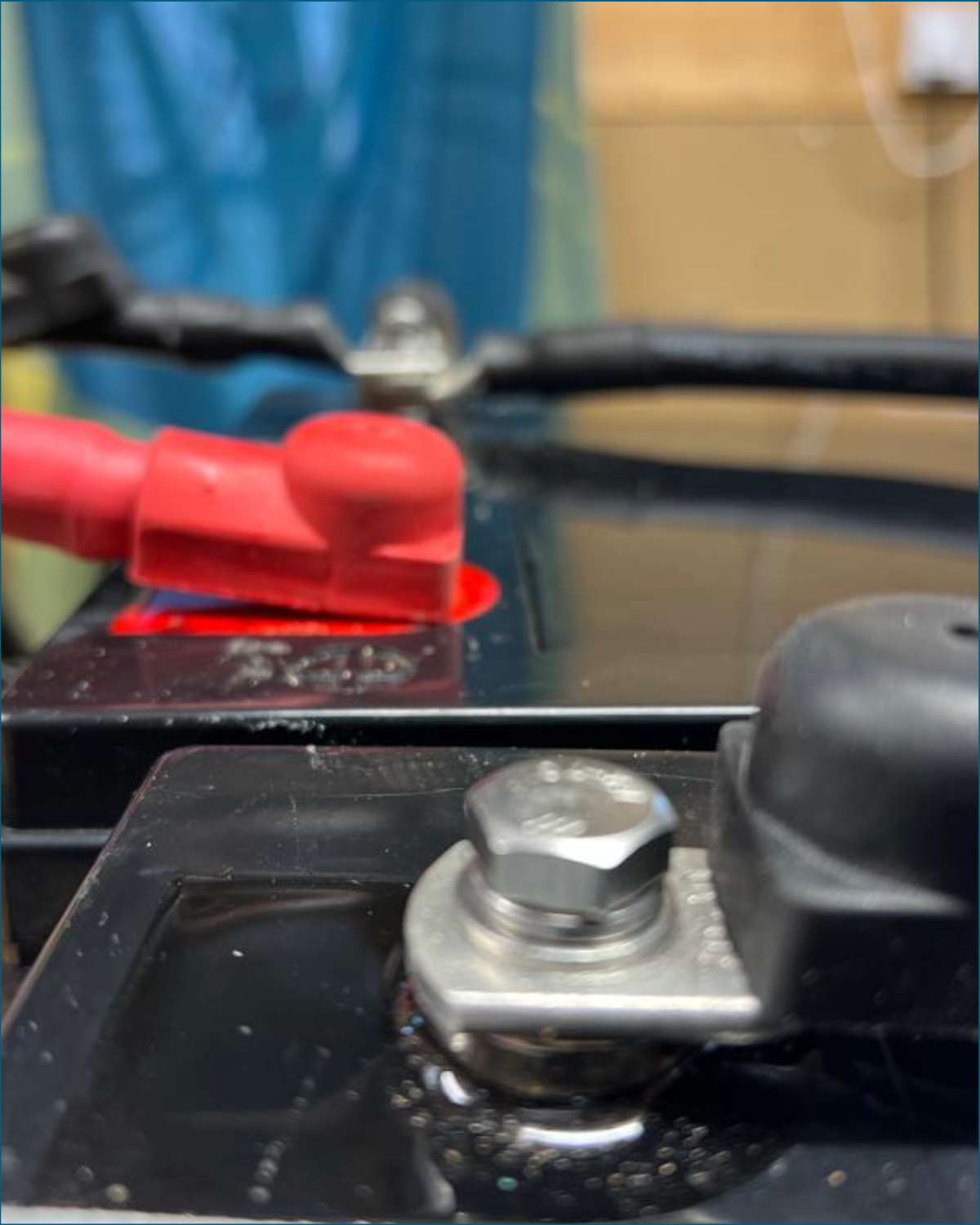Dive into the world of Mixing Solar Panels with our expert guide. Understand how mismatched panels can influence total output and discover strategies to optimize your solar array for peak efficiency.
What happens when you want to expand your existing solar array, but the same panels are no longer available?
Or you’ve been gifted another solar panel or want to integrate a portable one into your current system.
Can these different solar panels work together efficiently?
The topic of mixing and matching solar panels is complex and often misunderstood.
This article will explore the intricacies of mixing solar panels in a single array.
We’ll discuss how this configuration might impact your total power output and guide you through how you can set up your system for maximum efficiency.
At a Glance: Mixing Solar Panels
- On paper, mixing solar panels results in less power loss when wired in parallel.
- Wiring mismatched solar panels in series can provide a high enough voltage to charge the batteries from dawn to dusk.
- For the best results, use identical solar panels across the array.
- If you have to mix panels, try to closely match their wattages, voltages, and currents.
- Minimize or eliminate power loss with mixed solar panels by matching each panel’s electrical characteristics and using the optimum configuration.
How Wiring Configuration Affects Solar Panels Output
When connecting multiple solar panels, how they’re configured significantly influences their performance.
There are two primary methods to wire solar panels:
- series, and
- parallel.
Wiring solar panels in series means one panel’s positive terminal connects to the subsequent panel’s negative terminal.
This setup increases the voltage but produces the current that matches the lowest amperage in the array.
When the currents are identical, it remains steady.
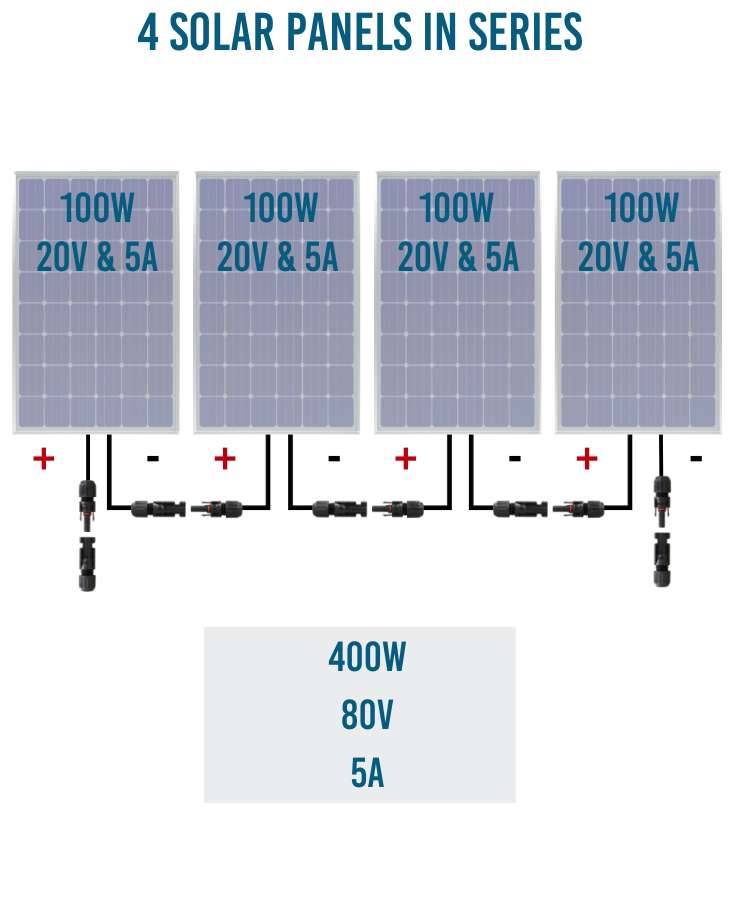
Conversely, a parallel configuration involves connecting multiple solar panels alongside each other.
Here, all positive terminals connect together, and all negative terminals link together.
This setup increases the current but produces the voltage that matches the lowest voltage panel in the array.
When the voltages are identical, it remains steady.
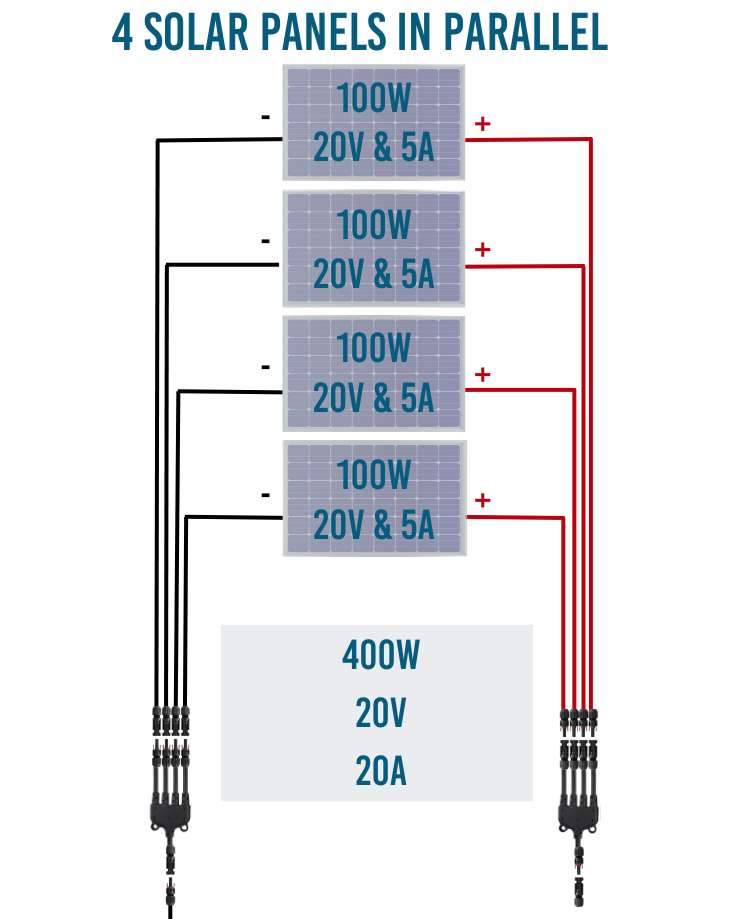
If all your panels are the same, read our post on whether you should wire them in series or parallel.
A third option is a hybrid of series and parallel. This setup involves connecting similar solar panels either in:
- series and then connecting the combined strings in parallel or
- parallel and then connecting the combined strings in series.
You can see from the diagram below that each string wired in series increases the voltage while using the lowest current.
When all the strings are connected in parallel, the current increases and the array produces the lowest voltage of the separate strings.
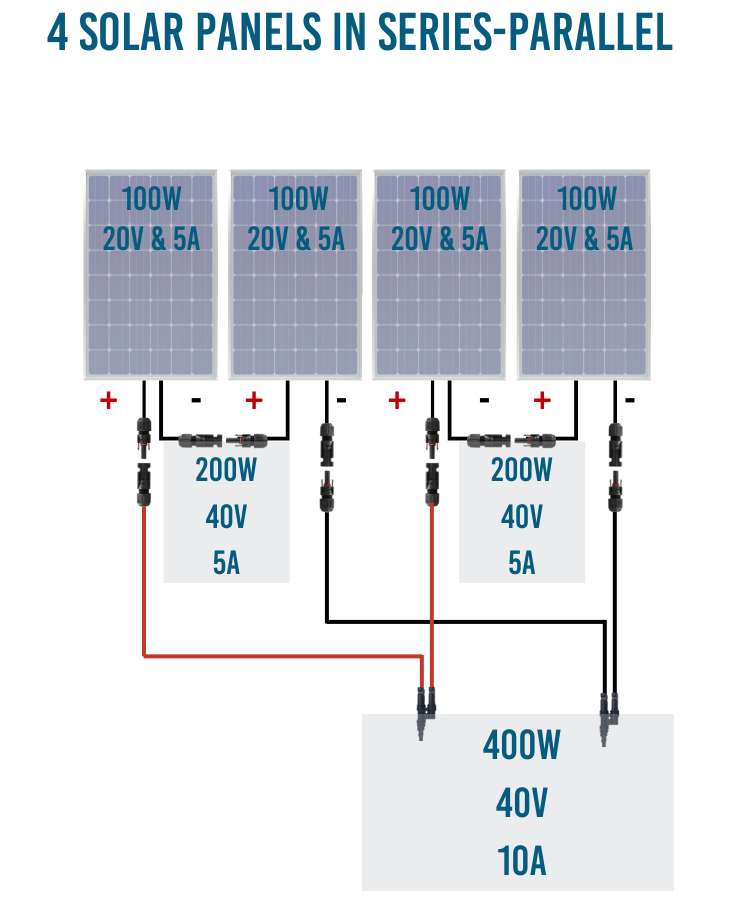
Understanding these concepts is fundamental when mixing solar panels.
Mismatched Solar Panels & How Best to Wire Them
Ideally, your solar setup will consist of identical solar panels.
They’ll be the same brand, type, and wattage, so operating currents and voltages will all be identical.
But we don’t live in an ideal world.
What happens when you mix panels of different brands, types, or wattages?
Your main concern should be matching the voltage and current.
It’s a delicate balancing act between series and parallel wiring configurations. Determining how best to configure the system isn’t immediately apparent.
Maximizing Power Output: The Math
For a Quick Answer Use our Solar Panel Series vs. Parallel Calculator.
Remember:
When solar panels are wired in series, the lowest amp rating is used in the calculation.
Parallel wiring uses the lowest voltage.
When a solar array uses a mix of panels with different ratings, the power output is no longer the same across all configurations.
Let’s take an example, which happens to be an identical setup one we used to have on Baloo, our Sprinter van conversion:
We had different wattage panels:
- Two solar panels: 2 x 95w panels, each rated at 4.5A and 21.1 volts, and
- One solar panel: 130w panel rated at 7.5A and 17.3 volts.
Wired in Series
We add the volts together and use the lowest current rating. So we get 21.1v + 21.1v + 17.3v = 59.5v at 4.5A.
We can get 267.75 watts from our 320 watt panels – a loss of over 16%.

Wired in Parallel
We add the amps together and use the lowest voltage rating. So we get 4.5A + 4.5A + 7.5A = 16.5A at 17.3v.
We can get 285.45 watts from our 320 watt panels – a loss of over 11%.

Combination of Series and Parallel
We’ll wire the 95-watt panels in one string because they are identical and keep the 130 watt panel in a separate string.
At this point, we have a further three options. We can either:
- wire the two identical panels in series, then connect them to the third panel in parallel, or
- wire the two identical panels in parallel, then connect them to the third panel in series or
- use two solar charge controllers, so we have two solar arrays with no mismatched panels.
And it makes a difference to how much power the panels can produce.
So, let’s take a look.
Wire Identical Panels in Series & Connect to a Third Panel in Parallel
- The 95w panels wired in series could produce 42.2 volts and 4.5 amps.
- The 130w panel could produce 17.3 volts and 7.5 amps.
- Combined, these two strings wired in parallel could produce 17.3 volts and 12 amps – a total of 207 watts, a loss of 35%.
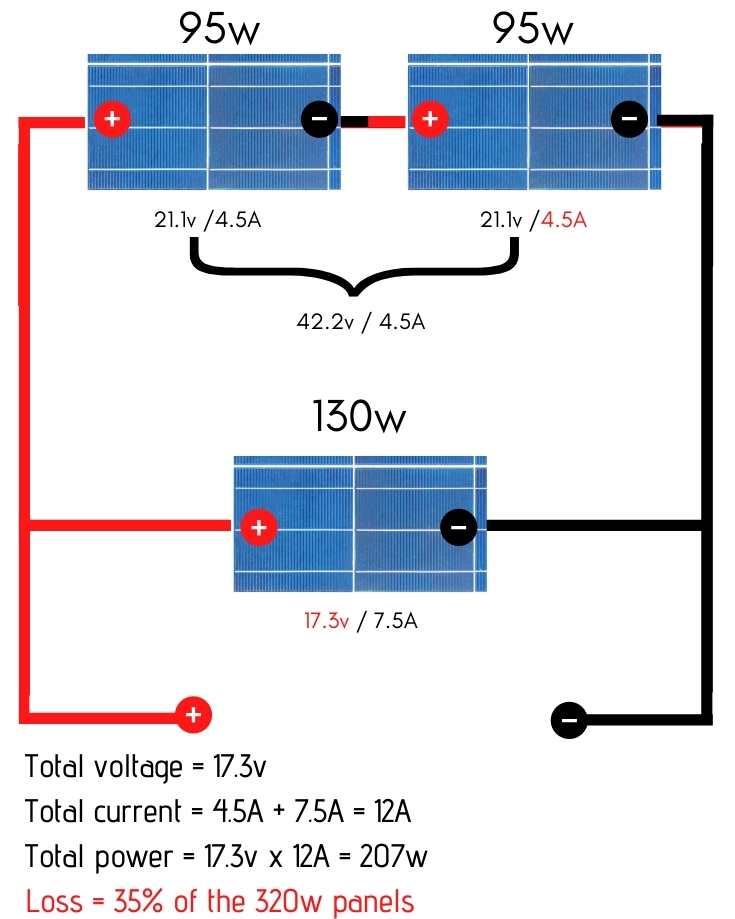
Wire Identical Panels in Parallel & Connect to a Third Panel in Series
- The 95w panels wired in parallel could produce 21.1 volts and 9 amps
- The 130w panel could produce 17.3 volts and 7.5 amps
- Combined, these two strings wired in series could produce 38.4 volts and 7.5 amps – a total of 288 watts, a loss of 9%.
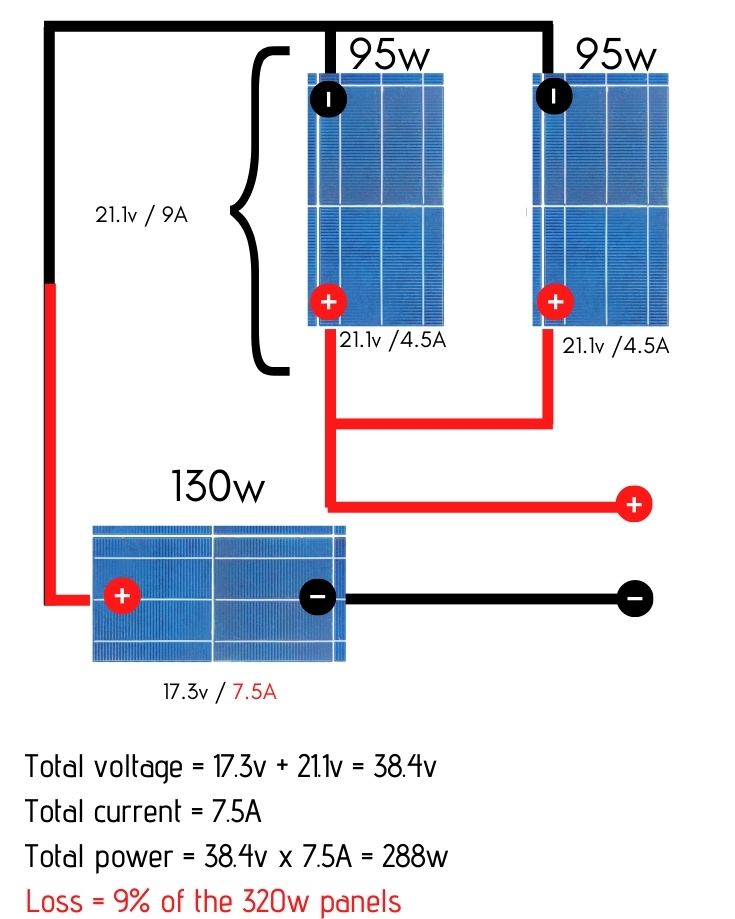
Install 2 Solar Charge Controllers and Separate the Solar Panels
We can see from the above scenarios that mixing solar panels in any combined configuration inevitably leads to a loss of power.
But you can avoid losses by separating the different solar panels into an array with no mismatched panels, each with a dedicated solar charge controller.
Using our example of two 95w panels and a 130w panel, we could wire the two 95 panels in series or parallel and connect them to a solar charge controller.
Separately, we can install the single 130w panel and connect it to a different solar charge controller.
Now, the battery bank is being charged from two separate solar panel arrays, and neither has a mismatched panel.
As a result, there is no power loss.
Result!
What’s the Best Wiring Setup for Mized Solar Panels?
Our Solar Panel Series and Parallel Calculator will give you a good idea of the total power output, current, and voltage you might expect from each wiring configuration.
But keep reading.
The decision isn’t black and white.
While the calculated results are interesting and valuable for sizing your solar charge controller, don’t wire your solar panels based solely on the minimum power loss.
The calculations are all based on the optimal operating conditions for the given solar panels.
In reality, though, those conditions may not always be met.
The Affect of Shade on Solar Panels
The position of the sun, cloud cover, and shade all impact the energy produced by solar panels.
This is particularly relevant for RVs or campers parked under trees or buildings.
The effects of shade vary depending on whether the solar panels are wired in series or parallel.
In a parallel configuration, if shade falls on any part of the solar array, the power output from that particular panel drops significantly, but the other panels remain unaffected.
However, in a series configuration, when one panel is shaded, it reduces its power output and impacts the performance of every other panel in the array.
Battery Charging Affect
While parallel wiring handles shade better, you must consider your battery charging.
A 12v battery requires at least 12.6v to charge. Under optimal conditions, solar panels in a parallel setup produce a voltage of around 17-22v.
But, this can fall under less ideal conditions.
For instance, four 100w panels, each with a rated voltage of 17.9v, can produce 17.9 volts in parallel, enough to charge the battery bank.
However, if their performance drops below 70%, the voltage will fall below the 12.6v needed for charging.
In contrast, the same panels wired in series could produce 71.6 volts and would need to fall to around 18% performance before they stop charging the batteries.
Therefore, while both series and parallel configurations have their merits, the choice between them should be guided by the specific conditions and requirements of your solar setup.
So What’s Best?
We had our mixed panels wired in parallel for a long time.
Why wouldn’t we? Parallel wiring handles the mixed solar panels far better than in series, and we wouldn’t suffer as much loss when we parked in the shade.
And then we sat around a campfire with fellow overlanders and discussed it all at length.
Convinced we might be wrong, we spent 5 minutes changing the setup from parallel to series the following day.
And we never looked back!
Our mismatched solar panels with an MPPT controller performed way better when wired in series.
Why?
Though we suffer slightly more losses during the optimum operating conditions, we produce a high enough voltage to charge the batteries from dawn to dusk.
So, we charge our batteries for more hours of the day than when we were wired in parallel.
Another result!
Our Recommendations
- Wherever possible, use the same solar panels throughout the entire array and wire them in series.
- If you must mix solar panels, try to match their wattages, voltages, and currents as closely as possible.
- If you have mixed panels, configure them to maximize the current by wiring similar panels in series.
- Pay special attention to anything that could cast a shadow on your panels, including aerials, satellite dishes, and vents.
- Avoid parking in the shade to maximize performance.
- Clean solar panels regularly.
- Remove any broken or damaged panels in the solar array.
- Use an MPPT controller to handle the higher system voltage when wiring in series.
Frequently Asked Questions
Is it OK to mix different solar panels?
Yes, you can mix solar panels!
Mixing different solar panels is not usually recommended because there will usually be some loss in how much solar-generated power they can produce.
However, by closely matching the electrical characteristics of each panel and using the most optimum configuration for your mismatched panels, you can minimize or even eliminate those losses.
Can you connect two different brands of solar panels?
Yes, you can connect two different brands of solar panels in either series or parallel.
The key is to ensure that the key electrical characteristics match as closely as possible – each panel’s voltage and current rating should be similar if not precisely the same.
If they don’t match, you must carefully calculate which type of connection will give you the best results.
How can I maximize my solar panel array’s performance?
To get the maximum possible power from your solar panel array, ensure all the panels are identical – the same wattage, current, and voltage.
Can solar panels of different watts be connected together in parallel, such as connecting 180 watts together with 150 watts?
Yes, you can connect mixed wattage solar panels in parallel.
However, be aware that the power output will be limited to that of the lowest-wattage panel – the 180-watt panel and 150-watt panel in your example.
You must also ensure that the electrical characteristics (voltage and current) match as closely as possible. Otherwise, you could see significant losses in power output.
If the characteristics don’t match closely enough, installing two charge controllers and splitting the array into two strings with no mismatched panels is best. This will give you maximum efficiency and power output from your solar panel system.
Graham Bogie

Graham is a seasoned marine electrical engineer with two decades of experience designing customized electrical systems for plant machinery and converting campers and overland vehicles. His expertise has led him to author the reputable Campervan Electrics Handbook and become the chief designer of the RV Wiring Design Tool. As a knowledgeable figure in the field, his YouTube channel, blog, Facebook group, and newsletter, offering electrical advice and product reviews, reach more than a million users each year.


